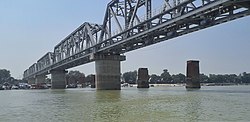Budaun district
District of Uttar Pradesh in India From Wikipedia, the free encyclopedia
District of Uttar Pradesh in India From Wikipedia, the free encyclopedia
Budaun district (Hindi pronunciation: [bəd̪aːjũː]; or Buaaun) is one of the districts of Uttar Pradesh state of India, with its headquarters in the town of Badaun. The district is part of the Bareilly division, and covers an area of 4,234 km2 (1,635 sq mi). According to legend, Budaun was named after the Ahir prince Budh.[1]
Budaun district | |
|---|---|
 | |
 Location of Badaun district in Uttar Pradesh | |
| Country | |
| State | Uttar Pradesh |
| Division | Bareilly |
| Headquarters | Badaun |
| Tehsils | 6 |
| Government | |
| • Lok Sabha constituencies | Badaun, Aonla (partly) |
| • Vidhan Sabha constituencies | 6 |
| Area | |
• Total | 4,234 km2 (1,635 sq mi) |
| Population (2011) | |
• Total | 3,127,621 |
| • Density | 740/km2 (1,900/sq mi) |
| • Urban | 826,000 |
| Demographics | |
| • Literacy | 52.91 per cent |
| Time zone | UTC+05:30 (IST) |
| Major highways | SH33, SH43, SH51, SH18, NH 93 |
| Website | https://badaun.nic.in/ |

After the British takeover in 1801, the area was part of Moradabad district, and parts were transferred to Bareilly district in 1805.[2] In October 1823, the district was created out of areas previously in both Moradabad and Bareilly districts, and it was originally called Sahaswan district after its headquarters of Sahaswan.[2] The headquarters was moved to Budaun in 1838.[2] The Encyclopædia Britannica Eleventh Edition wrote of Budaun:[3]
A town and district of British India, in the Rohilkhand division of the United Provinces. The town is near the left bank of the river Sot. [The population as of] 1901 [was] 39,031. There are ruins of an immense fort and a very handsome mosque of imposing size, crowned with a dome, and built in 1223 in great part from the materials of an ancient Hindu temple. The American Methodist mission maintains several girls' schools, and there is a high school for boys. According to tradition, Badaun was founded about A.D. 905, and an inscription, probably of the 12th century, gives a list of twelve Rathor kings reigning at Badaun (called Vodamayuta). The first authentic historical event connected with it, however, was its capture by Kutb-ud-din in 1196, after which it became a very important post on the northern frontier of the Delhi empire. In the 13th century two of its governors, Shams-ud-din Altamsh, the builder of the great mosque referred to above, and his son Rukd-ud-din Firoz, attained the imperial throne. In 1571 the town was burnt, and about a hundred years later, under Shah Jahan, the seat of the governorship was transferred to Bareilly; after which the importance of Badaun declined.
According to professor Goti John, the city was named Vedamooth (वेदामूथ) on an 11th-century stone inscription which is held at the Lucknow Museum. At that time, the region was called Panchal (पांचाल). According to a line of the inscription, there was a village named Bhadaulak (भदाऊँलक) near the city. Geographically, the city of Badaun is located near the Ganges, which the Hindus consider a holy river.[4][1][better source needed]
In 2006, the Ministry of Panchayati Raj named Budaun one of the country's 251 special funded cities (out of a total of 640).[5] It is one of the 34 districts in Uttar Pradesh currently receiving funds from the Backward Regions Grant Fund Programme (BRGF).[5]
The district comprises five tehsils: Budaun, Bisauli, Bilsi, Dataganj and Sahaswan.
There are six Vidhan Sabha constituencies in the district: Bisauli, Sahaswan, Bilsi, Badaun, Shekhupur and Dataganj. While Shekhupur and Dataganj are part of the Aonla Lok Sabha constituency, the rest are part of the Badaun Lok Sabha constituency.
| Year | Pop. | ±% p.a. |
|---|---|---|
| 1901 | 1,026,192 | — |
| 1911 | 1,054,293 | +0.27% |
| 1921 | 975,684 | −0.77% |
| 1931 | 1,010,467 | +0.35% |
| 1941 | 1,162,322 | +1.41% |
| 1951 | 1,251,152 | +0.74% |
| 1961 | 1,411,657 | +1.21% |
| 1971 | 1,645,967 | +1.55% |
| 1981 | 1,971,946 | +1.82% |
| 1991 | 2,448,338 | +2.19% |
| 2001 | 3,069,426 | +2.29% |
| 2011 | 3,681,896 | +1.84% |
| source:[6] | ||
According to the 2011 census Budaun district has a population of 3,681,896,[7] roughly equal to the nation of Liberia[8] or the US state of Oklahoma.[9] This gives it a ranking of 71st in India out of 640. The district has a population density of 718 inhabitants per square kilometre (1,860/sq mi). Its population growth rate over the decade 2001–2011 was 20.96%. Budaun has a sex ratio of 859 females for every 1000 males and a literacy rate of 52.91%.
After the formation of Sambhal district and separation of Gunnaur tehsil, the district had a population of 3,127,621 and a sex ratio of 872 females per 1000 males. 593,254 (18.97%) lived in urban areas. Scheduled Castes make up 553,497 (17.70%) of the population.[7]
The major urban areas in the district according to March 2015 estimates are Budaun (population 397,000), Ujhani (124,000), Sahaswan (118,000) and Kakrala (85,000).[citation needed]
The vast majority of the population residing in Budaun identifies with either Hinduism or Islam. Sikhs, Christians, and Jains also live in the region.[10]
At the time of the 2011 Census of India, 89.98% of the population of the district spoke Hindi and 9.93% spoke Urdu as their first language.[11]
Seamless Wikipedia browsing. On steroids.
Every time you click a link to Wikipedia, Wiktionary or Wikiquote in your browser's search results, it will show the modern Wikiwand interface.
Wikiwand extension is a five stars, simple, with minimum permission required to keep your browsing private, safe and transparent.